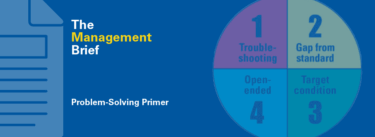I’ve found that there are essentially four different types of A3s:
- Problem Solving
- Proposal
- Status Report
- Strategic Planning
All these reports share a common underlying approach. Regardless of which type of A3 you are dealing with, your approach needs to follow PDCA thinking. The basic steps of this Plan-Do-Check-Act cycle are:
Make a plan (grasp the situation). Establish where you are, and compare this with where you want to be.
Put the plan into action/implement.
Check for effectiveness. Modify if necessary.
Reflect/Standardize, and Share.
Letís take a look at each of these A3 categories, and see where we can use them.
Problem Solving A3: In my experience at Toyota, I spent 75-80 percent of my time on these A3s. These problem-solving A3s will always follow the 8-step PDCA problem solving process. They should always be quantified and measured, stating a clear Gap to solve. There are ìcaused gapî problems, since they are created by situations where we arenít able to maintain a standard, or an ideal situation.
Proposal A3: A proposal A3 is future state oriented, articulating where and how you want to improve the situation by suggesting an idea. This type of improvement is normally focused on an area or department and targets the performance of a specific indicator. Also in this category would be the Strategy A3, which is similar, yet focuses more on value streams and higher level processes related to the company business plan.
In these types of A3s you start out by explaining the current state or background and why it needs to be improved. Is the current state affecting a Key Performance Indicator (KPI) of the company? Can you show some benefit analysis for the idea, and recommend how you will implement this, with timelines and milestones? As the implementation begins you will need to evaluate its effectiveness and have a follow-up plan that ensures the work conditions are sustainable. This type of A3 is often called a ìcreated gap.î You are trying to raise the bar or improve the situation or standard.
Status Report A3: A status report A3 can be a specific report showing the progress (on an weekly, monthly, quarterly basis) of a long-term project. It may show a Plan vs. Actual status, based on the expectations of the plan or project. Depending on the status, you could be asked to develop a short-term plan to get yourself back on the expected schedule if you fall short of a deadline.
I donít use this particular A3 often, and did so particularly when a product/model change required detailed long-term planning to ensure success at the end date. The benefits are that it brings the PDCA cycle to use once more, asking the right questions of where we are and where we want to be at the right times.
Strategy A3: A strategy A3 is normally focused on the company Hoshin (business plan) over the longer termóanywhere from 1 and up to 15 years out. My experience with this was mainly around the 1, 3, and 5-year planning. I would include the Proposal A3 in this category, since itís similar in nature to the strategy A3 but more narrowly focused. This A3 seeks to narrow the company gap from a current to future state based on what current business indicators are telling us what needs to happen. These types of A3 are normally authored by leadership at a higher level. They deal with topics such as a value stream between product and delivery that needs improvementósomething that cascades downward throughout all levels of the organization as individuals focus their daily work on this specific goal. I may have excessive warranty claims, for example, and want to reduce this by improving the quality of the product itself by a specific percentage. This high-level goal needs to be tracked as it cascades down to the daily work of people and teams. And, as will all categories, this A3 should follow PDCA thinking.†






